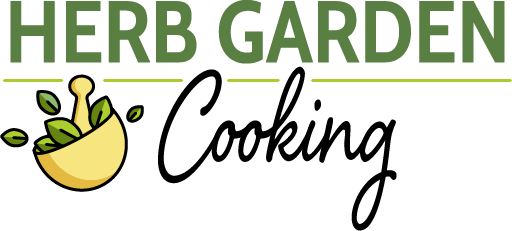This post may contain affiliate links which means I may receive a commission for purchases made through links. I only recommend products that I have personally used. As an Amazon Associate I earn from qualifying purchases. Learn more on my Private Policy page.

Growing and harvesting your own basil can be incredibly rewarding. This versatile herb adds a delightful touch to a wide range of dishes and is a must-have for any home gardener. To make sure you’re getting the most from the basil in your garden, it’s important to understand the importance of harvesting at the right time and using proper techniques.
How do you harvest basil without harming the plant? To harvest basil for continuous growth, make certain to regularly harvest from different parts of the basil plant, focusing on the topmost leaves, and never harvesting more the 1/3 of the plant’s total height. Leaving foliage enables photosynthesis and promotes continuous growth.
Proper pruning techniques not only promote healthier basil plants but also encourage more robust growth and higher yields. Learning different methods for preserving and storing fresh basil allows you to enjoy its vibrant flavors long after the growing season ends. Embracing these ideas will empower you to have an abundant and readily available source of flavorful basil.
Table of Contents
When to Harvest Basil
Ensuring you harvest basil at the right time is crucial to maximum flavor in your dishes. Here are some key points to keep in mind.
Optimal Growth Stage for Harvesting Basil
You can start to harvest basil when the plant reaches a height of 6 to 8 inches and has at least six sets of leaves. This ensures that the plant is mature enough to produce flavorful leaves without stunting its growth. Harvesting too early may result in small, underdeveloped leaves with less intense flavor.
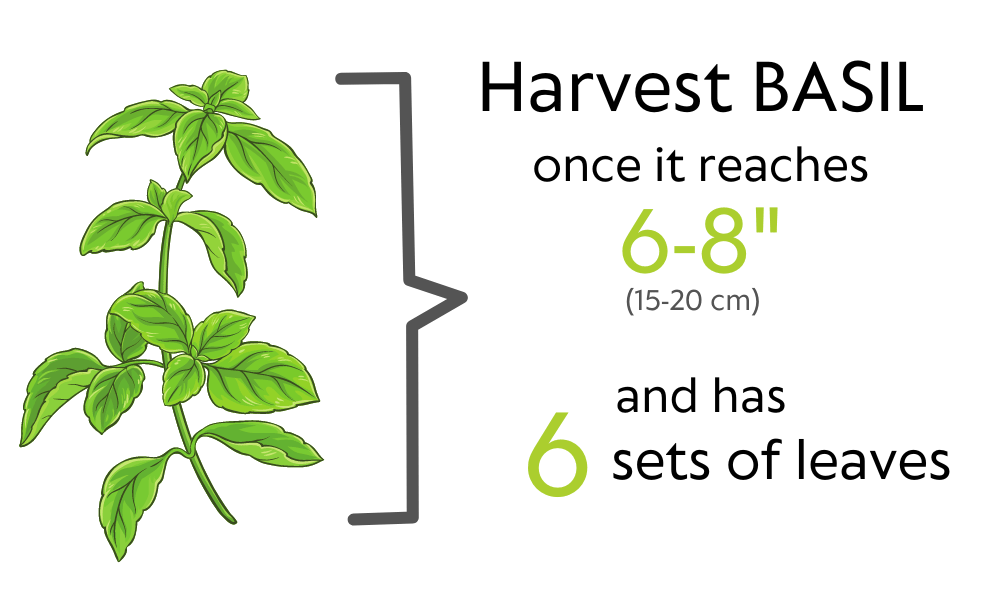
The Cool Morning Advantage: Ideal Conditions for Basil Harvesting
To get the best results, choose a cool morning for harvesting when the weather is pleasant and the plants are well-hydrated. This helps prevent wilting and ensures that you pick fresh, crisp leaves bursting with aroma. Avoid harvesting during hot afternoons as the heat can cause the essential oils in the leaves to evaporate, leading to a loss of flavor.
Taming Basil Flowers
Another important factor to consider is flowering. Basil plants tend to produce flowers as they mature, which can affect leaf production and flavor. For a larger yield of basil, it’s recommended to harvest basil leaves before the plant starts flowering. By doing so, you encourage more leaf growth rather than diverting energy towards flower production.
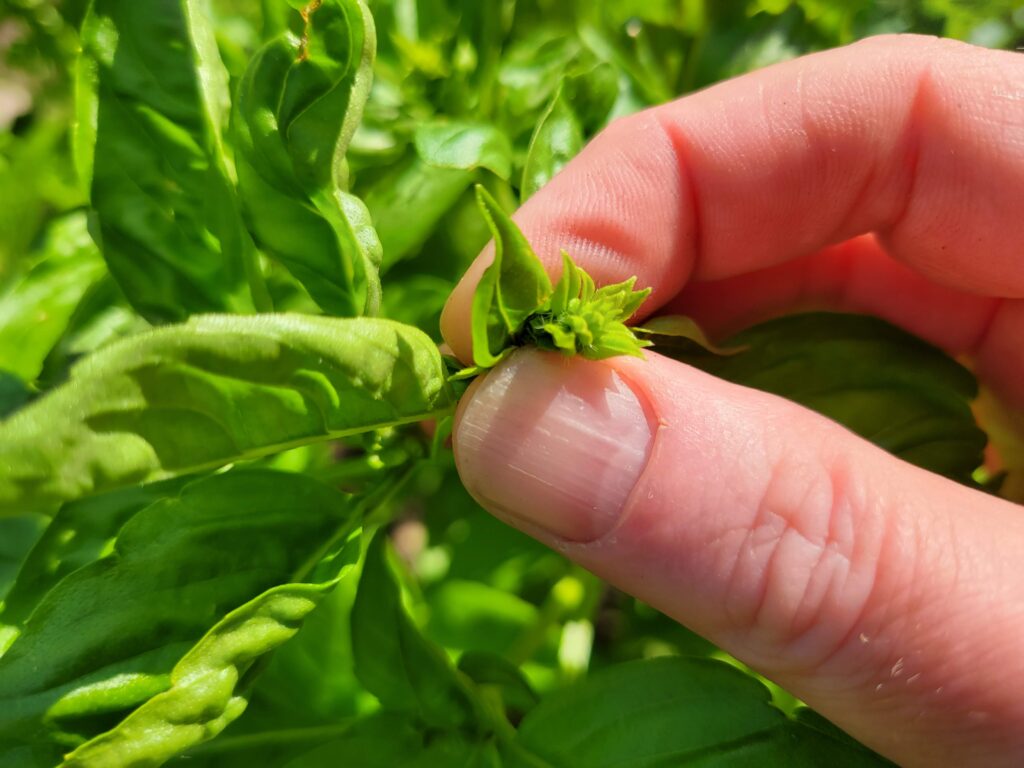
If you notice flowers starting to form on your basil plant, don’t worry! You can still salvage your harvest if you pinch off these flowers immediately. Removing them will redirect the plant’s energy back into leaf production, resulting in a fuller and more abundant harvest. However, if your basil has already flowered, don’t fret—although flowering may slightly diminish leaf flavor, you can still pick and use those leaves for culinary purposes.
Harvesting Basil Without Killing the Plant
Mastering the art of harvesting basil without harming its growth is essential for any herb enthusiast. With a few simple techniques, you can ensure a bountiful harvest while keeping your basil plants healthy and thriving.
Make Precise Cuts
It’s important to know where and how to make the cuts. To avoid stunting the plant’s growth, always cut about ¼-inch above where leaves are coming off the stem. This allows new plants to sprout from dormant buds located in leaf joints. By snipping at this precise location, you encourage side shoots to develop, resulting in a bushier and more productive plant.
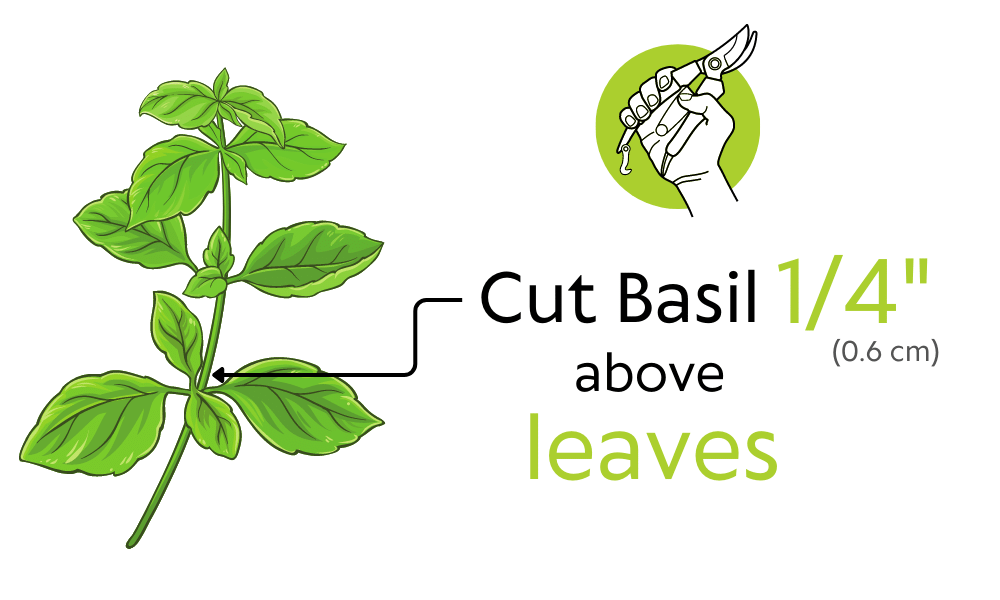
Harvest Regularly from Different Parts of the Plant
It’s not a good idea to remove a lot of basil from your plant all at once. Removing more than a third of the height in a single basil harvest can shock the plant and hinder its ability to recover. Instead, opt for regular harvesting every 7 to 10 days, ensuring you pick from different parts of the plant each time. This approach not only prevents excessive stress but also encourages branching on all sides. When harvesting smaller amounts, be sure sure to pinch off what you’re harvesting just above a leaf pair and don’t leave a stub. This will promote new growth so new leaves can emerge.
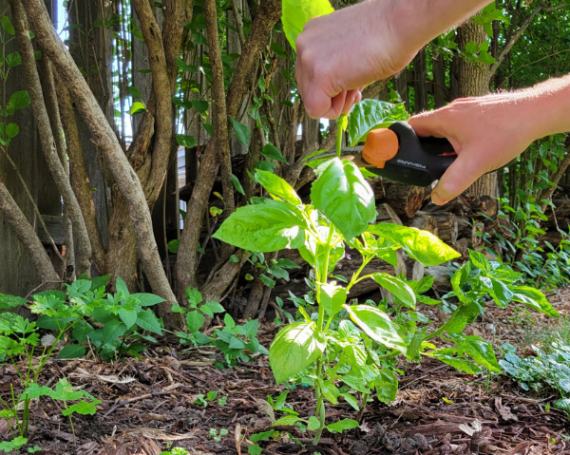
Focus on the Topmost Leaves
For mature basil plants, focus on harvesting the topmost leaves rather than plucking from lower sections. The upper leaves receive maximum sunlight exposure and contain higher concentrations of essential oils that contribute to flavor and aroma. It’s crucial not to pick more than 50% of the leaves during each harvest. Leaving enough foliage allows photosynthesis to continue effectively and ensures continuous growth.
Consider Companion Planting & Growing Conditions
In addition to these techniques for successful harvesting, there are other factors that contribute to overall plant health. Basil companion planting can help your garden thrive when it is grown alongside vegetables such as tomatoes or peppers. These combinations not only enhance flavor but also provide natural pest control benefits.
It is best to grow basil next to plants with similar growing preferences. Basil prefers direct sunlight for at least six hours a day and well-drained soil.
Basil Pruning Tips
Regular pruning throughout the growing season promotes branching and leaf production, resulting in a bushier plant with more harvestable leaves.
Use Sharp Tools
Make certain you’re using sharp pruning shears, herb snips, or scissors to make clean cuts when pruning basil leaves. Using dull tools may cause damage to the plant and increase the risk of infection. When trimming the leaves, start by removing any damaged or yellowing foliage. This allows the plant to focus its energy on producing healthy new growth.
Avoid Cutting the Woody Base
When pruning basil plants, it’s important to avoid cutting the woody part of the plant near the base. Basil won’t grow back from there, so it’s best to trim above a set of healthy leaves or just above a node where new growth is emerging. By doing so, you encourage lateral branching and ensure a fuller plant.
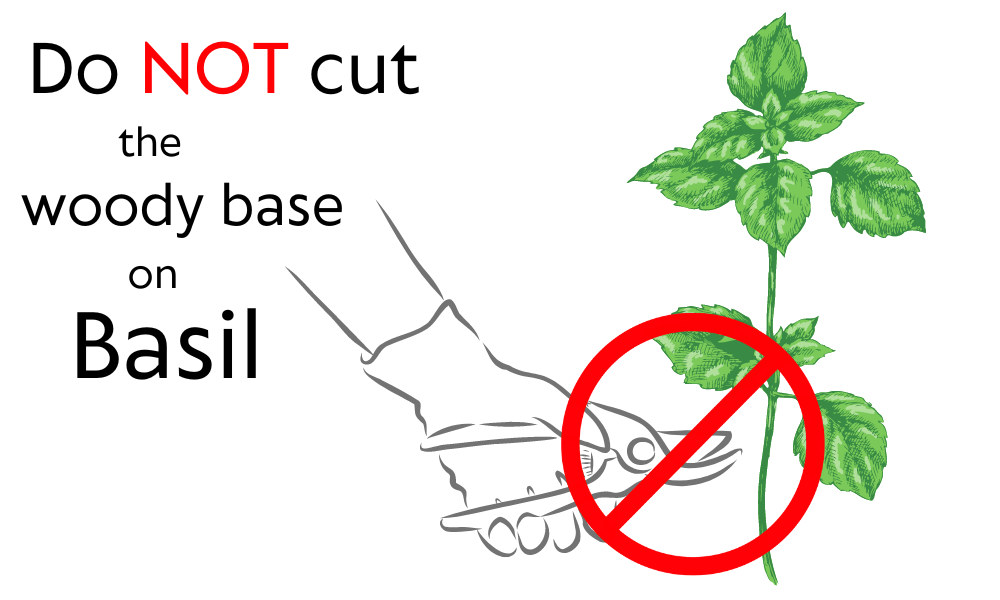
By following these basil pruning best practices, you can maintain healthy plants that produce an abundance of flavorful leaves throughout the growing season. Remember to use sharp tools, avoid cutting near the woody base, and also to remove flower buds promptly.
Preserving Fresh Basil
Preserving fresh basil leaves after harvest is essential to ensure that you can enjoy the aromatic flavor of this versatile herb all year round. Let’s explore various methods for preserving fresh basil and keep those delightful flavors alive.
Basil Water Bouquet: A Short-term Solution
You can preserve freshly harvested basil for short periods by making a water bouquet. Trim freshly picked basil stems and them place in water-filled jar. This arrangement will keep your basil fresh for several days on the kitchen counter. Change the water daily to maintain its freshness.

Freezing Basil in Ice Cube Trays: An Easy Long-term Option
Freezing basil using ice cube trays is one of the most popular methods for preserving fresh herbs like basil. It allows you to retain their vibrant flavors and colors for an extended period. To freeze your basil in this fashion, follow these steps:
- Preparation: Wash and dry your basil leaves thoroughly. Once they’re dry, remove the leaves from their stems.
- Chopping or Blending: Depending on your preference, you can either chop the basil leaves or blend them into a paste.
- Filling the Ice Cube Tray: Fill each compartment of the tray with the chopped or blended basil. Pour water, or olive oil for a richer flavor, over the basil until the compartments are full.
- Freezing: Place the tray in the freezer and let it freeze until the cubes are solid.
- Storage: Once frozen, you can transfer the basil cubes to a ziplock bag or another airtight container. Remember to label and date it for easier identification.
These convenient basil cubes can be easily added to soups, stews, sauces, or any other dish that calls for fresh basil.
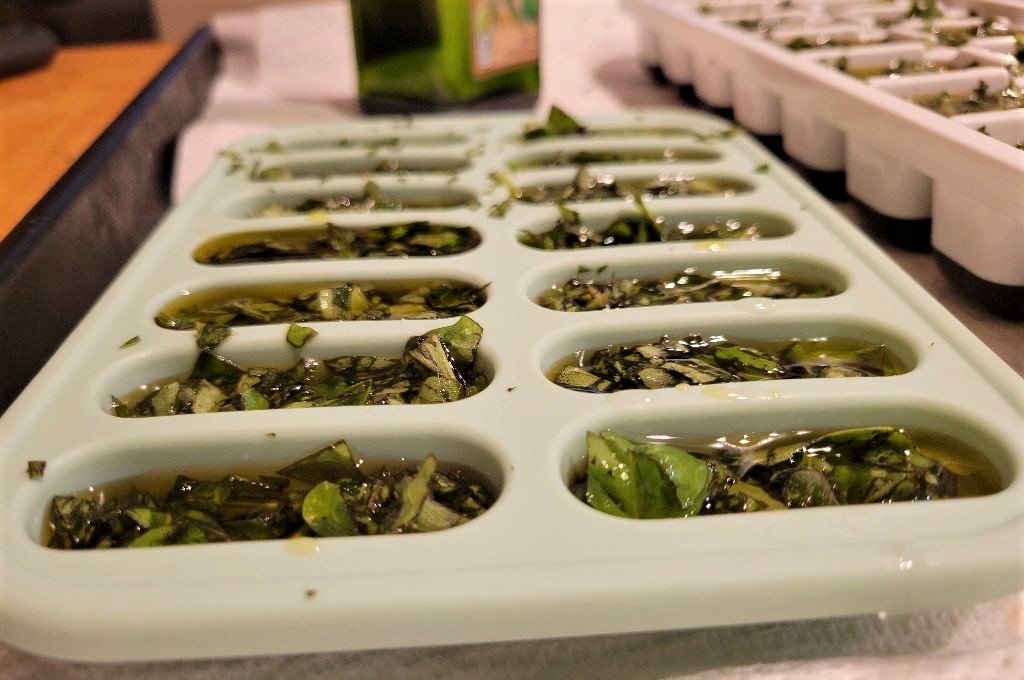
Basil-infused Oils and Butters
Another great way to preserve fresh basil is by infusing its flavors into oils or butters. Here’s how you can do it:
- Gently wash and pat dry your basil leaves.
- Place the leaves in a blender or food processor.
- Add your preferred oil (such as olive oil) or melted butter to the blender.
- Blend until you achieve a smooth consistency.
- Pour the mixture into sterilized jars and store them in the refrigerator.
These basil-infused oils and butters can be used to enhance the flavors of various dishes, from pasta sauces to grilled vegetables, giving them a delightful hint of basil freshness.
Herb Keepers: The Secret to Long-lasting Basil
If you want to keep your fresh basil at its best for an extended period, consider investing in a herb keeper. These specialized containers provide optimal conditions for storing herbs, including basil, by regulating humidity levels and providing proper air circulation. By keeping your fresh basil in such an environment, you can extend its shelf life and enjoy its flavors for weeks instead of days.
Preserving Basil Through Pesto
Pesto is not only a delicious sauce but also an excellent method for preserving fresh basil leaves. By blending together basil leaves, garlic, pine nuts (or any other preferred nut), Parmesan cheese, olive oil, salt, and pepper, you create a flavorful paste that can be stored in the refrigerator or freezer. Pesto serves as a versatile ingredient that adds depth and vibrancy to pasta dishes, sandwiches, marinades, and more.
Drying Basil for Long-Term Preservation
Drying basil is a popular method that not only extends its shelf life but also concentrates its taste, allowing you to enjoy this aromatic herb long after the growing season has ended.
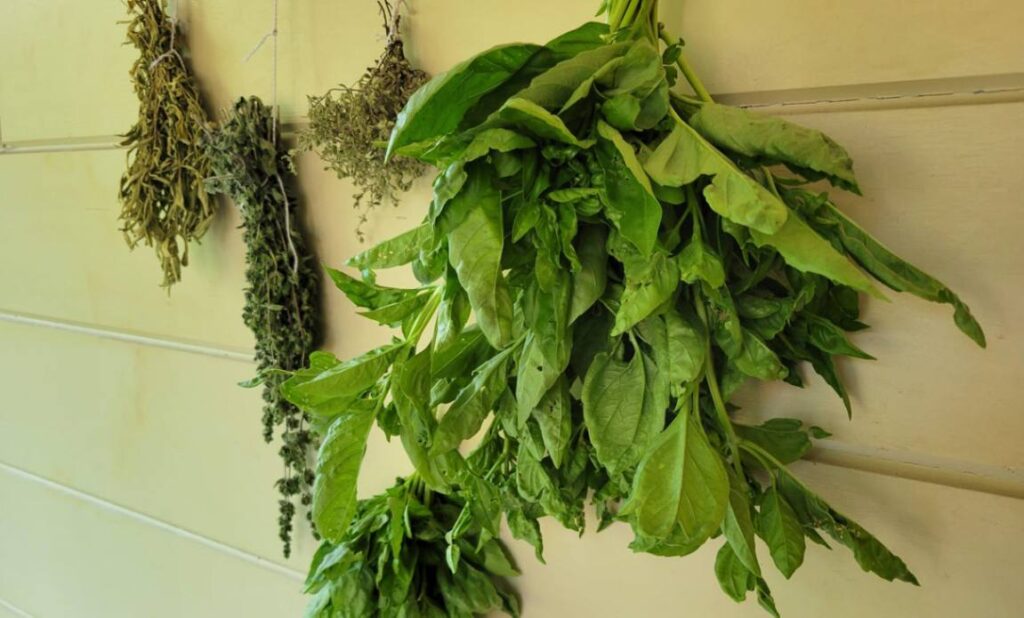
Air-Drying Basil
Air-drying is one of the simplest and most traditional ways to preserve basil. To air-dry basil, follow these steps:
- Harvest fresh basil leaves, discarding any damaged ones. Wash and pat them dry.
- Bundle the basil stem, tieing them together with twine or string.
- Hang bundles upside down in a warm, well-ventilated area away from direct sunlight.
- Allow 2-4 weeks for the basil to air-dry completely, considering humidity levels.
Air-dried basil retains much of its original flavor while developing a slightly more intense taste profile. Once completely dried, crumble the leaves into an airtight container and store them in a cool, dark place for long-term preservation.
Other Basil Drying Methods
Other methods for drying basil harvested from your garden include:
- Using a Food Dehydrator
- Oven Drying
- Air Fryer Method
- Microwaving
For more information, check out my article on 5 ways to dry basil and the experiment I conducted to determine the best way to dry basil. The results were frankly rather surprising.
Proper Methods for Storing Dried Basil
Drying basil is a tried and true method for extending the shelf life of this favorite herb. When properly stored, dried basil can last up to one year.
Store Dried Basil in Airtight Containers
To store dried basil, it is fundamental to use airtight containers to protect the herb’s quality. Opt for glass or plastic containers with secure lids to keep your dried basil fresh. Vacuum storage bags also serve as an excellent alternative for storing dried basil, as they provide the best conditions by eliminating the maximum amount of air.
Store in a Cool, Dark Place
To maintain the potency of your dried basil, it’s advisable to store it in a cool and dark place. Avoid storing it close to heat sources like stoves or ovens, as these can compromise its quality over time.
Regularly Inspect for Mold and Moisture
Regularly check your stored herbs to detect any signs of moisture or mold growth. Despite employing appropriate storage methods, there’s still a risk that humidity could degrade the quality of your dried basil. Should you spot any signs of dampness or mold, immediately remove and discard the affected parts.
By adhering to these proper storage methods for dried basil, you can significantly extend its shelf life and continue to relish its rich flavors for a more extended period.
Conclusion: Enjoy an Abundant Basil Harvest
Growing your own basil is a rewarding experience. It gives you a fresh and easily accessible supply of this fragrant herb for cooking. With a keen understanding of when and how to harvest basil leaves, as well as the different techniques for pruning and preserving basil, you can ensure a plentiful supply of this versatile herb throughout the year. Whether fresh or preserved, basil’s vibrant flavors can transform an array of dishes, making it a staple in any herb garden.
Frequently Asked Questions (FAQs)
How do you know when to harvest basil?
You can begin to harvest basil once the basil plant has reached at least 6-8 inches tall (15-20cm) and has 6 sets of true leaves. Look for mature leaves that are plump and vibrant in color. Harvesting too early can hinder growth and also leads to smaller, less flavorful leaves.
How long does dried basil last?
When properly stored in airtight containers away from heat and light, dried basil can retain its flavor for up to one year.
Can I store freshly harvested basil without refrigeration?
Placing freshly cut stems in a glass or a jar of water on your kitchen counter will keep them fresh for several days. Just remember to change the water daily.
Can I use wilted leaves from my basil plant?
It’s best to remove any wilted or yellow basil leaves as they can affect the overall health of your plant. However, you can still use these leaves if they haven’t started to decay.
Can I use basil flowers in my cooking?
While basil flowers are edible, they tend to have a stronger flavor and can be slightly bitter. Some people enjoy their taste, but others prefer to remove the flowers before using the leaves.
How often should I prune my basil plant?
Regular pruning is recommended to keep your basil plant healthy and encourage bushier growth. It’s recommended to harvest basil every 7-10 days, ensuring you leave enough leaves for regrowth.
Last Updated on 25 September 2023 by Bob Lee
